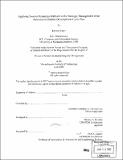Applying system dynamics methods to the strategic management of an automotive product development cycle plan
Author(s)
Esker, Edward (Edward Charles), 1964-
DownloadFull printable version (12.47Mb)
Other Contributors
System Design and Management Program.
Advisor
Nelson Repenning.
Terms of use
Metadata
Show full item recordAbstract
Automotive companies continue to refine their product development processes to reduce total development cycle time and to increase key consumer attributes of quality, safety, package, and design for the vehicles that are produced. Company project planners and vehicle program managers need effective techniques and methods to predict and manage product development processes in the context of an automotive company. Strategic managers desire a set of individual and aggregate vehicle program system dynamics models specifically developed for the automotive product development process to understand the resource implications in the creation of a vehicle cycle plan. This paper describes the individual and aggregate vehicle program system dynamics models that were developed, simulated, and analyzed using a representative automotive product development cycle plan. The relationships between resources, individual employee productivity, quality of the product development work, and the aspects of schedule pressure, work and rework, program management, employee movement, and the interactions between the product development phases were explored. The system dynamics models and corresponding simulation results are presented in this document along with the observations and insights obtained during the course of this study.
Description
Thesis (S.M.)--Massachusetts Institute of Technology, System Design & Management Program, 2000. Includes bibliographical references (p. 90-91).
Date issued
2000Department
System Design and Management Program.Publisher
Massachusetts Institute of Technology
Keywords
System Design and Management Program.